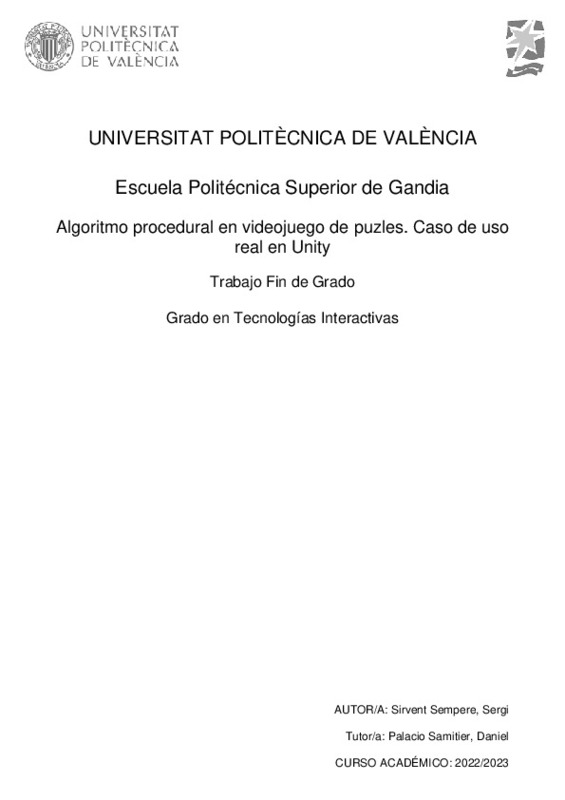|
Resumen:
|
[ES] Creación e implementación de un algoritmo procedural en un videojuego de puzles creado con el motor Unity. El objetivo de este trabajo es investigar el funcionamiento de la generación procedural y mostrar su correcto ...[+]
[ES] Creación e implementación de un algoritmo procedural en un videojuego de puzles creado con el motor Unity. El objetivo de este trabajo es investigar el funcionamiento de la generación procedural y mostrar su correcto funcionamiento en un videojuego.
El juego, llamado `Ice Tiles¿, se basa en cruzar un tablero de casillas de hielo, en el cual algunas son de hielo fino y otras de hielo duro, indistinguibles entre sí. El jugador podrá ayudarse de la luz solar para derretir las casillas de hielo fino, dejando así al descubierto las casillas de hielo duro. El jugador deberá memorizar el camino para que cuando acabe el periodo de luz solar, que serán unos cuantos segundos, pueda cruzar a la siguiente isla sin pisar ninguna casilla de hielo fino. Si el jugador pisa una casilla de hielo fino, este caerá al mar, se reiniciará el nivel y se penalizará en la puntuación del jugador.
El algoritmo es totalmente regulable debido a que los puzles deberán tener dificultades distintas conforme el jugador aumente de nivel. Además, los caminos de hielo duro se generarán aleatoriamente (pero siempre con una solución viable) siempre que el usuario juegue un nivel, así se conseguirá que la experiencia sea diferente cada vez que el usuario entre a un nivel.
Se pretende implementar enemigos y diferentes `Power ups¿, los cuáles también variarán su comportamiento y generación dependiendo de la dificultad indicada al algoritmo procedural.
El juego constará de interfaz y modelados básicos para una mayor inmersión en el juego.
Por tanto el proyecto constará de una primera parte en la que se mostrará la investigación relacionada con los algoritmos procedurales en Unity, con su creación y desarrollo, y por otro lado se mostrará el funcionamiento del mismo en un videojuego.
[-]
[EN] Creation and implementation of a procedural algorithm in a puzzle video game created with the Unity engine. The objective of this work is to investigate the operation of procedural generation and show its correct ...[+]
[EN] Creation and implementation of a procedural algorithm in a puzzle video game created with the Unity engine. The objective of this work is to investigate the operation of procedural generation and show its correct functioning in a video game.
The game, called 'Ice Tiles', is based on crossing a board of ice tiles, in which some are made of thin ice and others are made of hard ice, indistinguishable from each other. The player will be able to use sunlight to melt the thin ice squares, thus exposing the hard ice squares. The player must memorize the path so that when the period of sunlight ends, which will be a few seconds, they can cross to the next island without stepping on any square of thin ice. If the player steps on a tile of thin ice, the ice will fall into the sea, the level will be reset and the player's score will be penalized.
The algorithm is fully adjustable because the puzzles should have different difficulties as the player levels up. Also, hard ice paths will be generated randomly (but always with a viable solution) every time the user plays a level, thus making the experience different every time the user enters a level.
It is intended to implement enemies and different 'Power ups', which will also vary their behavior and generation depending on the difficulty indicated to the procedural algorithm.
The game will consist of interface and basic modeling for a greater immersion in the game.
Therefore, the project will consist of a first part that will show the research related to procedural algorithms in Unity, with its creation and development, and on the other hand, it will show how it works in a video game.
[-]
|







